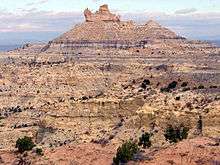Nacimiento Formation

The Nacimiento Formation is a sedimentary rock formation found in the San Juan Basin of western New Mexico (United States)[1] and named for the Nacimiento Mountains. It is a heterogeneous nonmarine formation composed of shale, siltstone, and sandstone,[2] deposited in floodplain, fluvial and lacustrine settings,[3] and made up of sediment shed from the San Juan uplift to the north and the Brazos-Sangre de Cristo uplift to the east.[4] It was deposited mostly between ~64.5 and ~61 million years ago, during the early and middle Paleocene.[5] The climate was humid and warm to hot.[6] This unit interbeds with the underlying Ojo Alamo Formation but is separated by an unconformity from the overlying San Jose Formation.[3]
Workers in the early 1900s divided the rocks of the Nacimiento Formation into two formations, the lower Puerco Formation and the upper Torrejon Formation.[7] This was rejected on the grounds that there were no lithological differences between the two, only differences in fossil faunas, making determination of which formation was present in a given area impossible if fossils could not be found.[8] The Puerco and Torrejon were retained as zones within the Nacimiento Formation, and their faunas became the basis of the Puercan and Torrejonian North American Land Mammal Ages.[9]
The Nacimiento Formation is divided into several subunits known as members. In outcrops in southern areas of the formation, the Puercan fauna is found in the Arroyo Chijuillita Member, the Torrejonian fauna is found in the Ojo Encino Member, and the uppermost Escavada Member lacks age-diagnostic fossils.[1] In northern outcrops, the two lower formations are indistinguishable, and are called the "main body".[5] Above them are two more members, as yet unnamed except in a thesis. They preserve a younger, Tiffanian fauna.[10] The Puercan and Torrejonian faunas are further subdivided into several biostratigraphic zones.[5]
Many fossils are known from the Nacimiento Formation, although bone is often altered into phosphatic concretions.[8] Fossils belonging to a number of different organisms have been found here, including: plants (mostly dicotyledonous angiosperms),[6][11] gastropods, freshwater bivalves,[12] cartilaginous fish and bony fish, salamanders, turtles, champsosaurs, amphisbaenians, lizards, snakes, crocodilians,[13] birds,[7] and a variety of archaic mammals. Mammalian groups represented include multituberculates, didelphid marsupials, insectivorans, plesiadapiforms, carnivorans, taeniodonts, mesonychids, condylarths, and cimolestans.[1]
References
- 1 2 3 Williamson, T.E.; Lucas, S.G. (1992). "Stratigraphy and mammalian biostratigraphy of the Paleocene Nacimiento Formation, southern San Juan basin, New Mexico". In Lucas, S.G.; Kues, B.S.; Williamson, T.E.; Hunt, A.P. San Juan Basin IV. New Mexico Geological Society Guidebook. 43. Socorro, New Mexico: New Mexico Geological Society. pp. 265–296. ISBN 99922-2-673-0.
- ↑ Schoch, R.M. (1981). "Taxonomy and biostratigraphy of the early Tertiary Taeniodonta (Mammalia: Eutheria)". Geological Society of America Bulletin. 92 (12): I 933-I 941, II 1982-II 2267. doi:10.1130/gsab-p2-92-1982.
- 1 2 Lucas, S.G.; Ingersoll, R.V. (1981). "Cenozoic continental deposits of New Mexico: an overview". Geological Society of America Bulletin. 92 (12): I 917–I 932, II 1807–II 1981. Bibcode:1981GSAB...92..917L. doi:10.1130/0016-7606(1981)92<917:CCDONM>2.0.CO;2.
- ↑ Lucas, S.G. (1984). "Correlation of Eocene rocks of the northern Rio Grande Rift and adjacent areas: implications for Laramide tectonics". In Baldridge, W.S.; Dickerson, P.W.; Riecker, R.E.; Zidek, J. Rio Grande Rift: northern New Mexico. New Mexico Geological Society Guidebook. 35. Socorro, New Mexico: New Mexico Geological Society. pp. 123–128.
- 1 2 3 Williamson, T.E. (1996). The beginning of the age of mammals in the San Juan Basin, New Mexico: biostratigraphy and evolution of Paleocene mammals of the Nacimiento Formation. New Mexico Museum of Natural History and Science Bulletin, 8. Albuquerque, New Mexico: New Mexico Museum of Natural History and Science.
- 1 2 Tidwell, W.D.; Ash, S.R.; Parker, L.R. (1981). "Cretaceous and Tertiary floras of the San Juan Basin". In Lucas, S.G.; Rigby Jr., J.K.; Kues, B.S. Advances in San Juan Basin paleontology. Albuquerque, New Mexico: University of New Mexico Press. pp. 307–332. ISBN 0-8263-0554-7.
- 1 2 Gardner, J.H. (1910). "The Puerco and Torrejon formations of the Nacimiento Group". Journal of Geology. 18 (8): 702–741. Bibcode:1910JG.....18..702G. doi:10.1086/621799.
- 1 2 Simpson, G.G. (1959). "Fossil mammals from the type area of the Puerco and Nacimiento strata, Paleocene of New Mexico". American Museum Novitates. 1957.
- ↑ Fassett, J.E. (1992). "Cretaceous and Tertiary rocks of the eastern San Juan Basin, New Mexico and Colorado". In Siemers, C.T.; Woodward, L.A.; Callender, J.F. Ghost Ranch. New Mexico Geological Society Guidebook. 25. Socorro, New Mexico: New Mexico Geological Society. pp. 225–230.
- ↑ Libed, S.A. (2005). Lithostratigraphy and mammalian biostratigraphy of the Torrejonian-Tiffanian transition in the Nacimiento Formation, northwestern San Juan Basin, New Mexico. M.A. thesis. Albuquerque, New Mexico: University of New Mexico.
- ↑ Anderson, R.Y. (1960). Cretaceous-Tertiary palynology, eastern side of the San Juan Basin, New Mexico. Memoir 6. Socorro, New Mexico: New Mexico Bureau of Mines and Mineral Resources.
- ↑ Hartman, J.H. (1981). "Early Tertiary nonmarine Mollusca of New Mexico: a review". Geological Society of America Bulletin. 92 (12): I 942–I 950. Bibcode:1981GSAB...92..942H. doi:10.1130/0016-7606(1981)92<942:ETNMON>2.0.CO;2.
- ↑ Sullivan, R.M.; Lucas, S.G. (1986). "Annotated list of fossil vertebrates from the Paleocene Nacimiento Formation (Puercan-Torrejonian), San Juan Basin, New Mexico". Journal of Herpetology. 20 (2): 202–209. doi:10.2307/1563945. JSTOR 1563945.